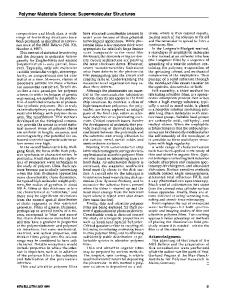Synthesis and characterization of novel multifunctional polymer grafted hollow silica spheres
- PDF / 750,710 Bytes
- 9 Pages / 584.957 x 782.986 pts Page_size
- 76 Downloads / 325 Views
Ali Murat Soydan Gebze Technical University, Material Science and Engineering, Nanotechnology Center, Cayirova 41400 Gebze-Kocaeli, Turkey
Ayhan Bozkurt
Department of Chemistry, Fatih University, 34500 Büyükçekmece, I_stanbul, Turkey (Received 30 March 2015; accepted 15 July 2015)
Multifunctionalized nanoparticles have a great attention owing to their unique advantages as ideal tools for gene/drug delivery, bioimaging, labeling, or intracellular tracking in biomedical applications. In the present work, azole functional Poly(glycidyl methacrylate) (PGMA) grafted hollow silica sphere (HSS) nanoparticles synthesized and characterized as biomaterials. For the preparation of HSS particles, a two-step method based on the sol–gel process was used in this study. HSS grafted with PGMA by free radical polymerization of (glycidyl methacrylate) (GMA) and HSPGMA (PGMA grafted HSS) modified with 5-aminotetrazole (ATet), 3-amino-1,2,4-triazole (ATri), and 1H-1,2,4-triazole (Tri) to obtain 1,2,4-triazole functional PGMA grafted HSS (HSPGMA-Tri), 5-aminotetrazole functional PGMA grafted HSS (HSPGMA-Tet) and 5-Amino-Triazole functional PGMA grafted HSS (HSPGMA-ATri) molecules via ring opening of the epoxide ring. Azole functional PGMA grafted HSS composites were doped with phosphoric acid. Fourier transform infrared spectroscopy (FT-IR), scanning electron microscopy (SEM), transmission electron microscopy (TEM), and atomic force microscopy (AFM) analyses were confirmed the grafting and modification of HSS. TGA and DSC were used to examine the thermal stability and homogeneity of the materials.
I. INTRODUCTION
Contributing Editor: Lennart Bergström a) Address all correspondence to this author. e-mail: [email protected] DOI: 10.1557/jmr.2015.222
The developed strategy allows the functionalization of the nanoparticles by a polymer carrying functional groups capable of reacting with the nanoparticle surface and various molecules such as azole compounds.13,14 In this context, Hah et al. demonstrated a two-step method to prepare mono disperse HSS. Pu et al. reported the functionalization of HSS and developed composite membrane as proton conducting systems.15,16 Additionally, Tsyalkovsky et al. have reported the grafting of surface of nanoparticles with Poly(glycidyl methacrylate) (PGMA).17 The special structure in the spheres and functional groups may hold more locked water and reduce the loading of the inorganic components, which may be beneficial for the water retention and improvement on the proton conductivity of the membranes. Due to the advantages of functionalization as a new azole functional polymer composite, the azole based membranes were developed which have dramatically increased due to their fundamental properties of chemical energy conversion in industrial devices such as proton exchange membrane fuel cells.18–21 An interesting approach can be the proton solvent comprising functional polymers that are thermally stable and having
2408
Ó Materials Research Society 2015
In the recent years, hollow silica spheres (HSS) h
Data Loading...











